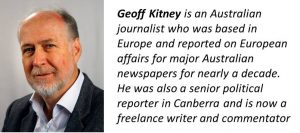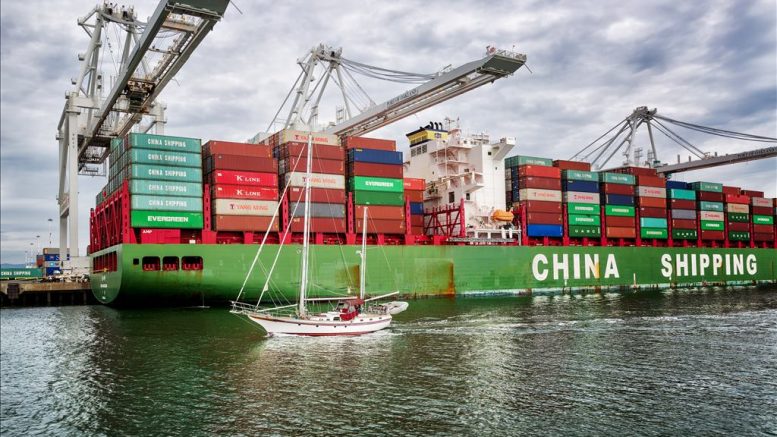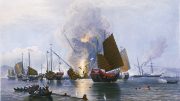By Geoff Kitney

As China seeks to exploit an unprecedented series of political shocks to the major western nations, trade policy has emerged as the key battleground on which the balance of global economic power will be fought out.
And in the wake of the shocks delivered by the Brexit vote and the outcome of the US presidential election, the first test of strength in this global power struggle is under way, with a decision to be taken within days about whether China should be granted equivalence with the major western economies within the World Trade Organization (WTO).
A December 11 deadline for WTO members to decide whether to change China’s status from “developing economy” to “market economy” is being preceded by intense lobbying by key Western governments and industries to delay such a change.
There are widespread concerns – especially in Europe and the United States – that allowing China “free market status” would pose a grave threat to a wide range of domestic manufacturing industries that could face sharply increased price competition from Chinese competitors.
The Obama administration decided a few days ago to oppose changing China’s status – a decision with which President-elect Trump concurs, not surprisingly given that he has talked about imposing a 45 per cent tariff on all Chinese imports which he claims is necessary to redress the “unfair” cheap prices of Chinese imports.
A resurgence of protectionist pressures would also be bad news for Britain and its post-Brexit trade ambitions … Trade experts are warning that, in the changing global scene, Britain might struggle to find willing FTA partners
The European Commission has proposed an alternative to granting China market economy status with a complicated new formula for assessing so-called “fair prices” for Chinese goods in international markets.
It is not clear yet, however, what the EU’s final position will be, with the European Parliament lobbying hard against upgrading China’s WTO status to “free market”.
The issue has arisen because, under the terms on which China was granted membership of the WTO in 2001, a 15-year deadline was set for it to be granted free market status, conditional on internal, market-based reforms in China. China insists that it has met its obligations and that the rest of the WTO membership should respect this and meet its obligations to China.
The issue is important because, once China is granted free market status, WTO provisions that currently allow other countries to impose anti-dumping duties on Chinese products will be dramatically weakened.
This is because assessing the fair market value of Chinese export goods would change from measuring prices against high production costs in Europe to measuring them against domestic production costs in China. Because China has much lower production costs than Europe, the duties that could be imposed on Chinese imports to Europe (and elsewhere) would be much lower than they are now.
The European steel industry, which employs nearly 330,000 people, is leading the campaign by European industries to oppose this change.
While Europe and the US fear for jobs, China argues that it deserves to be ranked as a market economy because of the extraordinary transformation that the Chinese economy has undergone in the 15 years since it joined the WTO.
The decision about China’s status within the WTO is symptomatic of the much bigger and wider question of what will happen to the balance of global trade as the US turns sharply inward and, under President-elect Trump, sharply more protectionist.
In the wider Western sphere, there is deep alarm at the prospects of the US ceasing to lead the world in fighting for freer trade and lower barriers to global trade and commerce.
There is also sudden alarm at the wider strategic consequences of this change, with concern growing that this will see China strongly assert itself to fill any void created by the Trump administration’s retreat from US leadership.
… Some experts [warn] that the only multi-lateral free trade agreement which appears likely to gain any momentum is the one in which China is lead power – the Regional Comprehensive Economic Partnership (RCEP)
At the regional level – in Europe in particular – the fallout from such tectonic shifts could be growing protectionist pressures generated by fear of the impact of Chinese economic and trade power on European industries and manufacturing jobs.
A resurgence of protectionist pressures would also be bad news for Britain and its post-Brexit trade ambitions. Prime Minister Theresa May has said post-Brexit Britain wants to be a global leader in promoting lower protection by signing a host of free trade agreements.
But trade experts are warning that, in the changing global scene, Britain might struggle to find willing FTA partners.
In this new, more fearful global trade environment, some experts are warning that the only multi-lateral free trade agreement which appears likely to gain any momentum is the one in which China is lead power – the Regional Comprehensive Economic Partnership (RCEP).
With TPP and the TTIP (see below) apparently close to death with the collapse of American leadership, the RCEP – which includes most of the trading nations of East and Southeast Asia – is now being promoted by China as the best hope for restoring momentum to the reduction of barriers to international trade and investment.
The accompanying table to this article sets out the increasingly bleak picture for multilateral trade agreements.
“Everything else is either stalled, moribund or going backwards,” a senior Australian government trade official told Chief-Exec.com.
“China sees this as potentially a great opportunity to show leadership and gain advantage over the US. If the US does shift towards isolationism, it is very likely that a lot of countries will turn towards China because of its rapidly growing economic power.
“The world could look very different after a few years of the Trump presidency.”
List of major multilateral free trade agreements
(existing and proposed)
RCEP (Regional Comprehensive Economic Partnership) |
|
|
16 countries involved, covering most of the Asian region. (parties are China, Japan, India. South Korea, Indonesia, Malaysia, Philippines, Singapore, Thailand, Brunei, Vietnam, Laos, Myanmar, Cambodia, Australia and New Zealand. Negotiations commenced in November, 2012, originally with the limited goal of creating an umbrella agreement for existing agreements between South East Asian nations. |
|
|
Goal: |
To cover trade in goods, services, investment, economic and technical co-operation, intellectual property and competition policy. |
|
Current status: |
China has been increasingly asserting a leadership role in RCEP and promoting it as an alternative to the Trans Pacific Partnership. Intensifying these efforts in light of President-elect Trump’s decision to withdraw the US from TPP. RCEP now seen as a potential vehicle for major increase in China’s influence in world trade and strategic influence in the Asia-Pacific. |
Doha Development Round |
|
|
164 countries involved, covering 95 per cent of world trade. Negotiations commended in November 2001 |
|
| Goal: |
To remove global tariff and non-tariff barriers to trade in industrial goods, services, intellectual property and agriculture Negotiations stalled July 2008 over objections by developing countries – especially India and China – to provisions on agriculture and industrial goods. |
| Current status: | On-going attempts to rejuvenate negotiations but no likelihood of an agreement in the foreseeable future. |
TPP (Trans Pacific Partnership) |
|
|
12 countries covering 40 per cent of global trade (US, Japan, Canada, Australia, Mexico, Chile, Malaysia, New Zealand, Peru, Vietnam, Singapore and Brunei) Negotiations commenced January 2008. Agreement signed in February, 2016. |
|
| Goal: |
To remove barriers to trade in all markets and to introduce rules for liberalising intellectual property rights. Negotiations conducted in secret. |
| Current status: | President elect Trump has declared he will withdraw US from the deal on day one of his presidency (January 20, 2017). Future of TPP uncertain. |
TTIP (Trans Atlantic Trade and Investment Agreement) |
|
|
A proposed free trade area covering the European Union and the United States, estimated to be worth 120 billion euros to the EU and 90 billion to the US, an estimated 50 per cent increase in total EU-US trade Negotiations commenced February 2013. |
|
| Goal: |
To increase market access, to streamline regulations and to provide clear rules to allow greater sharing of intellectual property. Negotiations conducted in secret. |
| Current status: | Negotiations are proceeding, but amid intense public opposition. President-elect Trump has signalled he will kill TTIP. |
EU-China investment agreement |
|
|
To cover economic relations between China and all EU countries, estimated to be worth one billion euros a day in trade, investment and other service industries such as tourism and education (China is now the EU’s biggest trading partner). Negotiations commenced in January 2014. |
|
| Goal: | To remove barriers and to establish clear rules for facilitating a deeper economic relationship and to lay foundations for a full bilateral free trade agreement. |
| Current status: | Negotiations on an investment agreement are continuing. Once completed, negotiations on a full FTA are expected to commence. |
NAFTA (North American Free Trade Agreement) |
|
|
An agreement between the United States, Canada and Mexico. Came into force in 1994, amid predictions of huge economic benefits for all three countries. |
|
| Goal: | To eliminate barriers to trade and investment in the north American nations. |
| Current status: |
Generally seen as having delivered less than promised. Blamed in the US for allowing the exporting of American manufacturing jobs to Mexico. Criticised in Canada for giving big American corporations excessive powers. President-elect Trump has called it “a disaster for the United States”. Future uncertain. |
CETA (Comprehensive Economic and Trade Agreement) |
|
| A free trade agreement between the European Union and Canada. | |
| Goal: |
To remove 98 per cent of trade barriers between the EU and Canada. EU claims it will lead to savings of over half a billion euros a year in taxes on exports to Canada plus greatly increased market access for both countries. Negotiations commenced in May, 2009. The deal was signed by Canada in October, 2016. It now has to be ratified by all EU member states. |
| Current status: |
Will come into operation once EU ratification process in completed. Strong opposition to CETA is on-going, based on criticism that it weakens European consumer rights and only benefits big business. Still possible that CETA will fail to be ratified by an EU state, effectively killing it. |
European Economic Area Agreement |
|
|
An access to the single market agreement involving 28 EU members states and three non-EU countries (Norway, Iceland and Liechtenstein). Came into effect in 1994. |
|
| Goal: | To allow countries neighbouring the EU to trade and gain access to the benefits of the single market without becoming full EU members. |
| Current status: |
Allows the free movement of goods, services, capital and people between the European single market and the non-EU states. Seen by the Brexit forces in the United Kingdom as the model for a similar agreement between the UK and the EU post-Brexit. But EU has made it clear access to the single market can only be on the basis that it also includes free movement of people. |
Other free trade agreements
-
There are 23 other smaller multilateral and bilateral free trade agreements now in operation.
-
At least another 20 are currently being negotiated.





